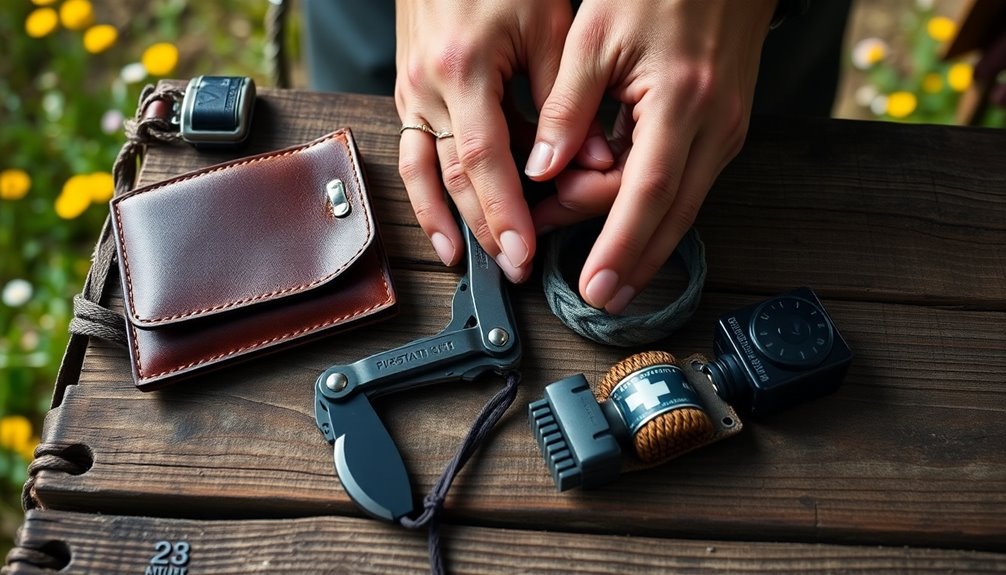Best EDC Carry: Essential Gear for Everyday Preparedness
The best edc carry focuses on equipping yourself with essential items that enhance your preparedness and convenience in daily life. This guide will help you understand the key components of an effective everyday carry (EDC) setup, ensuring you are ready for various situations.
Understanding EDC Carry Essentials
Everyday carry refers to the items you consistently have on hand to assist with daily tasks or emergencies. Knowing what to include in your EDC can streamline your day and prepare you for unexpected challenges.
Key Items for EDC Carry
- Multi-tool: A versatile tool combining several functions.
- Flashlight: For visibility in low-light conditions.
- First-aid kit: Basic medical supplies for minor injuries.
- Fire starter: Essential for emergency warmth or cooking.
These items serve as the foundation of a reliable EDC setup, providing functionality and peace of mind.
Steps to Build Your EDC Kit
- Assess Your Needs: Identify your daily activities and potential emergencies.
- Choose Quality Gear: Invest in durable tools from reputable brands.
- Organize Your Kit: Use a compact bag or pouch to keep items accessible.
- Regularly Review Contents: Update your kit based on changing needs or new gear options.
For example, if you frequently travel at night, prioritize a high-lumen flashlight in your EDC.
Selecting the Right Multi-tool

A multi-tool is often considered the cornerstone of any EDC setup due to its versatility. Choosing the right one requires understanding its features and how they fit into your lifestyle.
Criteria for Choosing a Multi-tool
- Functionality: Look for essential tools like pliers, screwdrivers, and knives.
- Size and Weight: Ensure it fits comfortably in your pocket or bag without being cumbersome.
- Material Quality: Stainless steel options tend to be more durable and resistant to corrosion.
Selecting a multi-tool that meets these criteria ensures you’re equipped for various tasks without carrying multiple individual tools.
Steps to Select Your Multi-tool
- Research Brands: Compare different manufacturers known for quality products.
- Read Reviews: Consider user feedback regarding performance and durability.
- Test Before Buying: If possible, handle the tool to assess comfort and ease of use.
For instance, brands like Leatherman offer models tailored specifically for urban settings versus outdoor adventures.
Incorporating Personal Safety Items

Safety is paramount when considering what goes into your everyday carry kit. Including personal safety items can enhance your preparedness significantly.
Important Safety Items
- Pepper spray or self-defense tool: Provides personal protection against threats.
- Whistle: Useful for signaling during emergencies where communication is crucial.
Integrating these items into your EDC not only promotes personal security but also encourages confidence in handling unforeseen situations.
Steps to Add Safety Items
- Evaluate Local Laws: Ensure compliance with regulations regarding self-defense tools in your area.
- Select Non-lethal Options: Choose tools designed primarily for deterrence rather than harm.
- Practice Usage: Familiarize yourself with how each item works before needing it in an emergency scenario.
For example, carrying a whistle allows you to signal others if lost while hiking alone.
FAQ
What should I consider when building my first EDC?
When starting an everyday carry kit, focus on practicality based on your lifestyle needs—think about common scenarios where you’d require specific tools or supplies, such as commuting or outdoor activities.
How often should I update my EDC?
It’s advisable to review and update your kit every few months or whenever there’s a significant change in routine—this ensures that all items remain relevant and functional according to current needs.
Can I customize my EDC?
Absolutely! Personalizing your everyday carry kit allows you to select items that resonate with you personally while meeting practical requirements—consider including unique gadgets or specialty tools relevant to hobbies or interests.
By following these structured guidelines, you’ll develop an effective everyday carry system tailored specifically towards enhancing preparedness while accommodating individual preferences within the US context.
Best EDC Carry: Essential Gear for Everyday Preparedness
The best EDC carry (Everyday Carry) is crucial for anyone looking to be prepared for unexpected situations. Whether you are commuting, hiking, or just going about your daily routine, having the right tools can make a significant difference. This guide will help you understand what to include in your EDC kit, how to choose reliable items, and tips for effective packing.
EDC Packing Tips
Packing your EDC effectively starts with understanding your personal needs and lifestyle. Here are some strategies to consider:
- Assess Your Daily Environment: Think about where you spend most of your time—home, office, outdoors—and tailor your gear accordingly.
- Prioritize Versatility: Choose items that serve multiple purposes. A multi-tool can handle various tasks without adding extra bulk.
- Stay Lightweight: Aim for a compact setup that does not weigh you down. Consider materials like titanium or high-strength polymers which provide durability without excess weight.
- Regularly Review Your Kit: As your daily activities change, so should your gear. Reassess every few months to ensure it meets current needs.
Survival Toolkits
A well-rounded survival toolkit is essential for any EDC setup. Here are some must-have items:
- Multi-tools: Brands like Leatherman and Victorinox offer models with pliers, screwdrivers, knives, and more in one compact unit.
- Flashlights: Tactical flashlights from brands such as Fenix or SureFire provide powerful illumination in a small form factor.
- First Aid Kits: Basic first aid supplies should include band-aids, antiseptic wipes, gauze pads, and adhesive tape. Look for kits that fit easily into bags or pockets.
- Personal Defense Items: Depending on local laws and personal comfort levels, consider pepper spray or a tactical pen as non-lethal self-defense options.
Emergency Preparedness Gear
Your EDC should also include gear specifically designed for emergencies:
- Water Filtration Systems: Compact filters like the Sawyer Mini allow you to purify water from natural sources quickly.
- Emergency Blankets: These lightweight blankets retain body heat and take up minimal space in your pack.
- Fire Starting Tools: A reliable fire starter such as ferro rods or waterproof matches can be invaluable during survival situations.
Lightweight Carrying Strategies
Carrying all this gear doesn’t have to feel cumbersome if you follow these strategies:
- Choose the Right Bag: A small backpack or tactical sling bag allows easy access while distributing weight evenly across your back.
- Use Pouches and Organizers: Keep similar items together using pouches within your bag—this makes finding what you need easier without rummaging through everything.
- Belt Carriers for Quick Access: Consider holsters or sheaths that attach to belts for frequently used items like knives or flashlights.
What Are The Most Reliable Items For An EDC Kit?
When selecting reliable items for an everyday carry kit, focus on quality over quantity:
- Look for products made from durable materials designed to withstand wear and tear.
- Check reviews and ratings online; reputable brands often have proven track records based on user experiences [Source].
- Ensure tools have warranties; this indicates manufacturer confidence in their product’s longevity.
How Do I Choose The Best Gear For Everyday Emergencies?
Choosing the right gear involves evaluating several factors:
- Assess potential risks in your environment—urban areas may require different tools than rural settings.
- Determine which skills you possess; select gear that complements those abilities (e.g., if you’re skilled at starting fires but not at first aid).
- Prioritize essential functions—gear should be practical enough that you’ll use it regularly rather than sitting idle.
Can I Customize My Everyday Carry Setup?
Absolutely! Customizing an everyday carry setup allows it to reflect personal preferences while meeting specific needs:
- Select items based on individual lifestyle requirements; if you’re often outdoors, prioritize outdoor-specific tools like compasses or portable stoves.
- Experiment with configurations until you find what works best; try carrying different combinations over a week-long period before settling on a final setup.
Next Steps
Building an effective EDC kit requires thoughtful selection of versatile tools tailored to personal needs and environments:
- Start by listing necessary functions based on common scenarios faced daily (e.g., commuting vs outdoor activities).
- Research top-rated products within each category using trusted sources [Source].
- Assemble a trial kit that includes selected items; test them out over two weeks before finalizing choices.
Track success by noting how often each item proves useful during real-life situations—aiming for at least three uses per week per tool will indicate its value in emergency preparedness efforts.
By following these guidelines and incorporating reliable resources into your everyday carry routine, you’ll enhance both preparedness and peace of mind during uncertain times ahead.
For more information about prepping essentials visit Society 1776.
